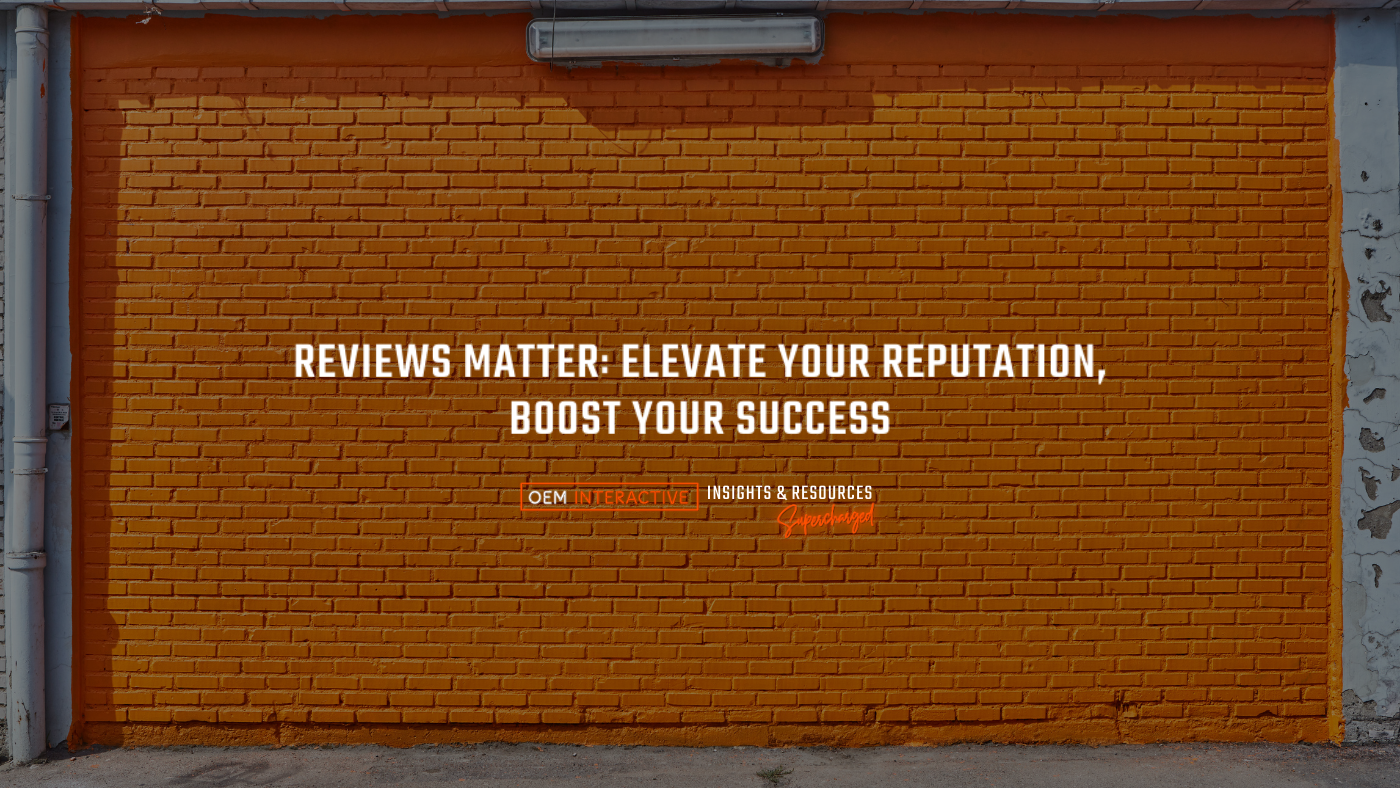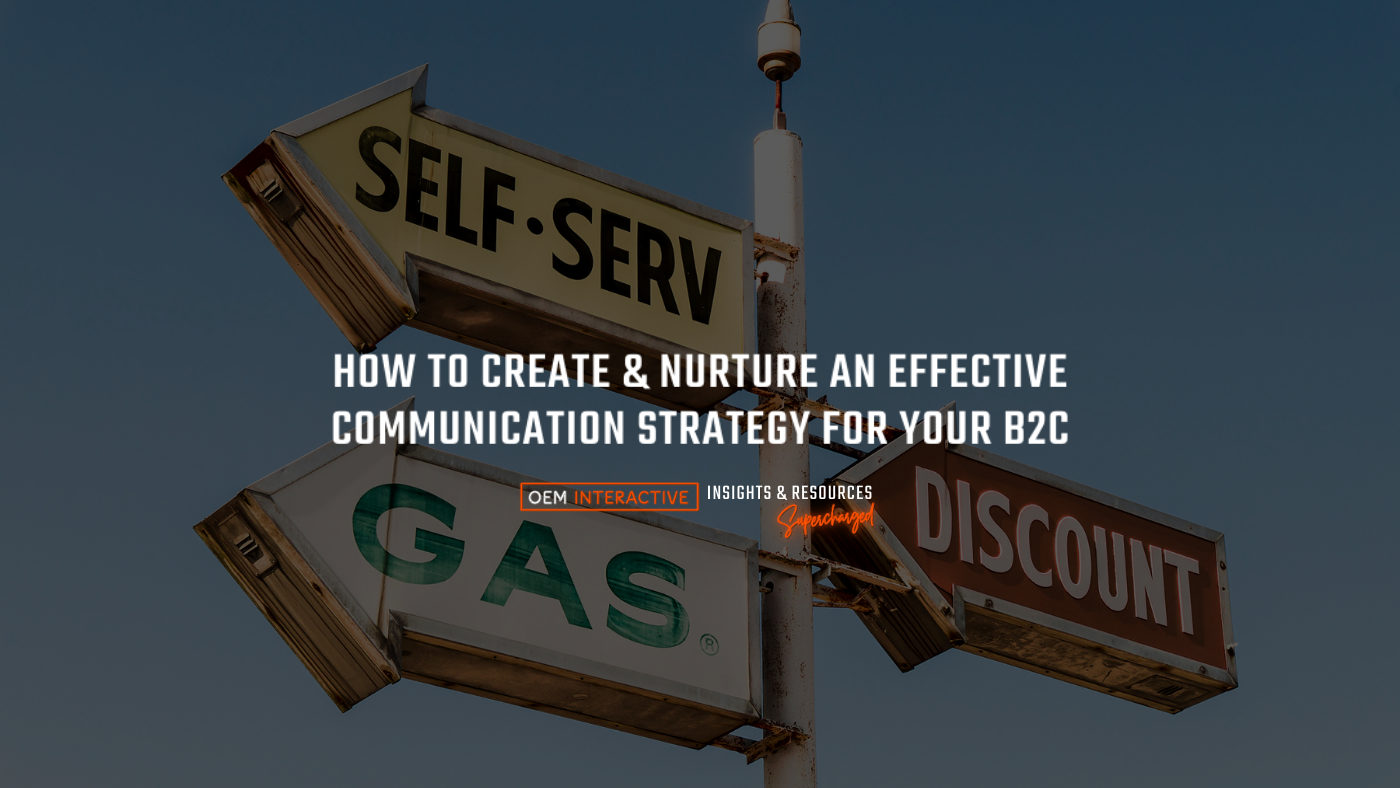One of the most frequently asked questions we receive from our partners is how they can increase their bottom line and profitability. You can be selling truck loads of parts and accessories, but we all know that it doesn’t matter if you’re not bringing in a profit.
In This Episode, We Discuss:
- Setting Realistic Expectations (1:30)
- Having a plan for success
- What is your definition of success or goal are you setting?
- Marketing is NOT a sprint…it is a MARATHON!
- Setting a realistic budget & determining where that budget is spent.
- Training Your Parts Staff (4:28)
- Understanding upsell opportunity
- Engaging your customer
- Offer Something Different (5:45)
- Creating bundle deals, open box sales, clearance sales and other incentives.
- Communication with your marketing partner is KEY!
- Offer Something Different (5:45)
VIDEO TRANSCRIPT
Aaron: In this week’s episode, we are with Ashley Robertson, Head of Customer Success, at OEM Interactive. Where we are breaking down ways to increase profitability for your parts department.
Aaron: All right, we are back again, with another edition of In The Pit Stop OEM Interactive. Aaron Watters, here, and I am joined, again, by Miss Ashley Robertson, our Head of Customer Success, here at OEM Interactive. Ashley, how are you doing?
Ashley: Thank you. Excellent.
Aaron: Yes, love to hear it. Ashley, you’re on the front lines, day in, day out, with our partners. Talking to them, daily. One of the most frequently asked questions, that you hear, is how can we increase profitability? How can we increase that bottom line number?
Ashley: Yep.
Aaron: Everybody’s focused on that bottom line number, right?
Ashley: Yep, the GM’s focused on it. that makes parts managers focused on it. we’re incredibly sensitive to it. you know, just knowing that, really, our customers get some of the best ROI in the industry, so …
Setting Realistic Expectations
Aaron: Yes, yes. I think, the most important thing, that you know we have to communicate with our partners, is setting realistic expectations.
Ashley: Definitely, right from the beginning. Having a plan, setting expectations, and understanding how we’re going to get there.
Aaron: Yeah. Once again, everybody’s definition of success is different.
Aaron: Right? Some people just want that incremental 20, 30, $40,000, in revenue.
Aaron: Because that’s what they can handle.
Aaron: Then, others want you know a million dollars a month.
Ashley: And they want to get there fast.
Aaron: And they want to get there first.
Aaron: So, the biggest thing is setting those realistic long-term goals.
Ashley: Yes.
Aaron: You know, you talked about being fast.
Ashley: Yes.
Aaron: But marketing isn’t a sprint-
Ashley: That’s right.
Aaron: It’s a marathon.
Ashley: That’s right, it’s a marathon.
Aaron: We have to set those long-term realistic goals.
Ashley: Yeah. Some of the things, that really play into that, are setting, based on your goal setting, a realistic budget. You know, doing a competitive analysis of the market. What is the market doing, right now? Where should your pricing matrix be? So that you can compete with some of the big box retailers.
You know, keep in mind, you’re out there with eBay, with Amazon, and competing with other dealerships. That doesn’t mean that you have to have the lowest price out there, but you certainly want to be competitive enough to where you’re getting people’s eyeballs.
Aaron: Yeah, absolutely. Doing your homework.
Ashley: Exactly.
Aaron: Understanding. If you’re working with a digital marketing company, or a marketing company, you know, you talked about budget. Where’s that budget being allocated? understanding where, how, where we’re going to place those media dollars?
Aaron: Or these advertising dollars?
Ashley: Right.
Aaron: Right? We’re going to put them on these platforms. We’re going to measure ROI, on all those different platforms. Some months, we may use this as a strategy. Other months, we may use this.
Ashley: Changing up the tools. Yep. It changes, for brand, even, depending on how competitive your brand is. The strategy, for a BMW store, and a Toyota store, and a Lexus store, might not be all the same.
Aaron: That’s a really, really, really good point. Because, every brand is different, every bread has different consumers.
Ashley: Mm-hmm (affirmative).
Aaron: Right? Kia is not going to be the same strategy as BMW, or Mercedes, or Porsche, or Audi.
Aaron: Right? There’s a different customer base there, you know, different customer demographic. They are playing in different ponds, and reacting to different media messages, differently. As opposed to the Porsche consumer, or the Audi consumer.
Ashley: Exactly.
Aaron: Right, so that’s-
Training Your Parts Staff
Ashley: And, with knowing your customer, we can sort of come around, and tie that into training your parts staff to understand upsell opportunities, because that’s going to help you make more profitable.
Aaron: Yeah, absolutely. That upsell opportunity, really gets back to be actively engaged. Right?
Ashley: Exactly.
Aaron: You want to talk about being profitable, and focusing on the bottom line, don’t be an order taker. Being in the sales world, years ago, they always talked about the guys who stood next to the fax machine.
Aaron: Yeah, I’m showing my age.
Ashley: People want personal interaction.
Aaron: You know, they would there, and be order takers, and wait for the order to come in.
Aaron: Rather than talking to their customers, and getting on the phone, and engaging with them.
Ashley: Exactly.
Aaron: And really trying to find unique opportunities, to upsell them on more products.
Ashley: Sure, and building that relationship, so that, later on, they have that trust with you, they’re more likely to call you back. They’re more likely to remember your web store name. You know, it all plays into why you want to have that personal interaction.
Aaron: Yeah.
Offering Something Different
Ashley: Then, tying into that, just offering something different, than just the typical, what every other competitor’s offering. So, you know, you have an OEM catalog. How can you box items, to offer bundle deals, or different clearance items, open box sales, these kinds of things? So you have to just be thinking about that.
Aaron: Absolutely. Creating those promotional incentives, for them, as well as communicating to your marketing partners, what your incentives are, and what your kickbacks are. Right? So if we, as a marketing partner, we only see, maybe, sometimes, like 90% of it.
Aaron: Right? And we don’t know, in some cases, what your incentives are.
Ashley: If you’ve got a big incentive, to sell floor mats, we need to know about that, so that we can push them, and you can get that kick back, at the end of the quarter, and that all plays into your profitability.
Aaron: Yeah. So the more communication, and us, understanding those types of incentives, that you’re having, within the month, or knowing that heres your promotional calendar, for those incentives throughout the course of the year, then, we can actually put that plan together, ensure that you’re hitting your back end goals.
Aaron: Your kickbacks.
Aaron: You know, your co-op bucks. That’s huge. Those are the types of things, that are going to affect your profitability, and your bottom line, that we can work with you on.
Ashley: Definitely.
Aaron: On a daily, weekly, monthly basis.
Ashley: Yep.
Aaron: Right? Just to recap, here, we’ve got things that will directly affect your bottom line on, a daily, weekly, monthly basis. Upsell opportunities, be actively engaged with your customers, bundle deals, what are the incentives, and-
Ashley: Communicate with your marketing partner.
Aaron: Communicate with your marketing partner, understanding, creating that the definition of success, and setting those realistic long-term goals. Long-term goals. Brands weren’t built in a day built. You didn’t just open up the front end of the dealership-
Aaron: And, you know, in one day, and just-
Ashley: You want to see month-over-month growth.
Aaron: Open the doors and all these cars are going off a lot.
Aaron: It takes time. Ensuring that we’ve got to plan, a long-term plan, for growth, and we’re doing whatever we can to hit those goals. Also, not being afraid to pivot and adjust. If we’re exceeding those goals, well then, you know what, let’s set the bar higher.
Ashley: Right. Right. Definitely.
Aaron: If we’re not hitting those goals, okay, well, maybe we’ve got to readjust, and our goals need to be at this level, and what are we going to do to get here, and here, and here. I think these are all great. You guys need to try to implement these things, take these things to heart, and be actively engaged. The game has changed and it’s continuing to change. If you’re not out there, just evolving, and not being … Taking a pivot, every once in a while.
Aaron: Because consumers are everywhere, you really have to be changing with that environment. Be a chameleon. Right?
Ashley: Yeah. Well, and the internet is changing rapidly, so you have to be on the front lines.
Aaron: Yeah. It’s going from one marketplace, to this social network, to here, to there, so be actively engaged. But Ashley, thank you.
Ashley: Yeah, thank you.
- Having a plan for success
Aaron: Again, as always. Thanks again, for joining us, with another edition of In The Pit Stop. See you next time.




